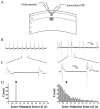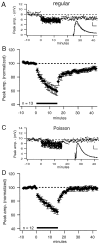LTD induction in adult visual cortex: role of stimulus timing and inhibition
- PMID: 11264306
- PMCID: PMC6762413
- DOI: 10.1523/JNEUROSCI.21-07-02308.2001
LTD induction in adult visual cortex: role of stimulus timing and inhibition
Abstract
One Hertz stimulation of afferents for 15 min with constant interstimulus intervals (regular stimulation) can induce long-term depression (LTD) of synaptic strength in the neocortex. However, it is unknown whether natural patterns of low-frequency afferent spike activity induce LTD. Although neurons in the neocortex can fire at overall rates as low as 1 Hz, the intervals between spikes are irregular. This irregular spike activity (and thus, presumably, irregular activation of the synapses of that neuron onto postsynaptic targets) can be approximated by stimulation with Poisson-distributed interstimulus intervals (Poisson stimulation). Therefore, if low-frequency presynaptic spike activity in the intact neocortex is sufficient to induce a generalized LTD of synaptic transmission, then Poisson stimulation, which mimics this spike activity, should induce LTD in slices. We tested this hypothesis by comparing changes in the strength of synapses onto layer 2/3 pyramidal cells induced by regular and Poisson stimulation in slices from adult visual cortex. We find that regular stimulation induces LTD of excitatory synaptic transmission as assessed by field potentials and intracellular postsynaptic potentials (PSPs) with inhibition absent. However, Poisson stimulation does not induce a net LTD of excitatory synaptic transmission. When the PSP contained an inhibitory component, neither Poisson nor regular stimulation induced LTD. We propose that the short bursts of synaptic activity that occur during a Poisson train have potentiating effects that offset the induction of LTD that is favored with regular stimulation. Thus, natural (i.e., irregular) low-frequency activity in the adult neocortex in vivo should not consistently induce LTD.
Figures








Similar articles
-
Role of GABAA-Mediated Inhibition and Functional Assortment of Synapses onto Individual Layer 4 Neurons in Regulating Plasticity Expression in Visual Cortex.PLoS One. 2016 Feb 3;11(2):e0147642. doi: 10.1371/journal.pone.0147642. eCollection 2016. PLoS One. 2016. PMID: 26841221 Free PMC article.
-
Transient synaptic potentiation in the visual cortex. I. Cellular mechanisms.J Neurophysiol. 1997 Mar;77(3):1269-83. doi: 10.1152/jn.1997.77.3.1269. J Neurophysiol. 1997. PMID: 9084595
-
Spike-timing-dependent plasticity of neocortical excitatory synapses on inhibitory interneurons depends on target cell type.J Neurosci. 2007 Sep 5;27(36):9711-20. doi: 10.1523/JNEUROSCI.2513-07.2007. J Neurosci. 2007. PMID: 17804631 Free PMC article.
-
Associative synaptic plasticity in hippocampus and visual cortex: cellular mechanisms and functional implications.Rev Neurosci. 1996 Jan-Mar;7(1):29-46. doi: 10.1515/revneuro.1996.7.1.29. Rev Neurosci. 1996. PMID: 8736677 Review.
-
Spike-Gamma Phase Relationship in the Visual Cortex.Annu Rev Vis Sci. 2022 Sep 15;8:361-381. doi: 10.1146/annurev-vision-100419-104530. Epub 2022 Jun 6. Annu Rev Vis Sci. 2022. PMID: 35667158 Review.
Cited by
-
Timing in the absence of supraspinal input II: regularly spaced stimulation induces a lasting alteration in spinal function that depends on the NMDA receptor, BDNF release, and protein synthesis.J Neurosci. 2009 Nov 18;29(46):14383-93. doi: 10.1523/JNEUROSCI.3583-09.2009. J Neurosci. 2009. PMID: 19923273 Free PMC article.
-
Naturalistic Spike Trains Drive State-Dependent Homeostatic Plasticity in Superficial Layers of Visual Cortex.Front Synaptic Neurosci. 2021 Apr 15;13:663282. doi: 10.3389/fnsyn.2021.663282. eCollection 2021. Front Synaptic Neurosci. 2021. PMID: 33935679 Free PMC article.
-
Erasing synapses in sleep: is it time to be SHY?Neural Plast. 2012;2012:264378. doi: 10.1155/2012/264378. Epub 2012 Feb 28. Neural Plast. 2012. PMID: 22530156 Free PMC article. Review.
-
The role of neurotrophins in neurotransmitter release.Neuroscientist. 2002 Dec;8(6):524-31. doi: 10.1177/1073858402238511. Neuroscientist. 2002. PMID: 12467374 Free PMC article. Review.
-
Spike timing in CA3 pyramidal cells during behavior: implications for synaptic transmission.J Neurophysiol. 2005 Aug;94(2):1528-40. doi: 10.1152/jn.00108.2005. Epub 2005 May 4. J Neurophysiol. 2005. PMID: 15872069 Free PMC article.
References
-
- Abbott LF, Sen K, Varela JA, Nelson SB. Synaptic depression and cortical gain control. Science. 1997;275:220–222. - PubMed
-
- Abraham WC, Bear MF. Metaplasticity: the plasticity of synaptic plasticity. Trends Neurosci. 1996;19:126–130. - PubMed
-
- Abraham WC, Mason-Parker SE, Logan B. Low-frequency stimulation does not readily cause long-term depression or depotentiation in the dentate gyrus of awake rats. Brain Res. 1996;722:217–221. - PubMed
-
- Artola A, Singer W. Long-term depression of excitatory synaptic transmission and its relationship to long-term potentiation. Trends Neurosci. 1993;16:480–487. - PubMed
-
- Artola A, Bröcher S, Singer W. Different voltage-dependent thresholds for inducing long-term depression and long-term potentiation in slices of rat visual cortex. Nature. 1990;347:69–72. - PubMed
Publication types
MeSH terms
Grants and funding
LinkOut - more resources
Full Text Sources
Miscellaneous
